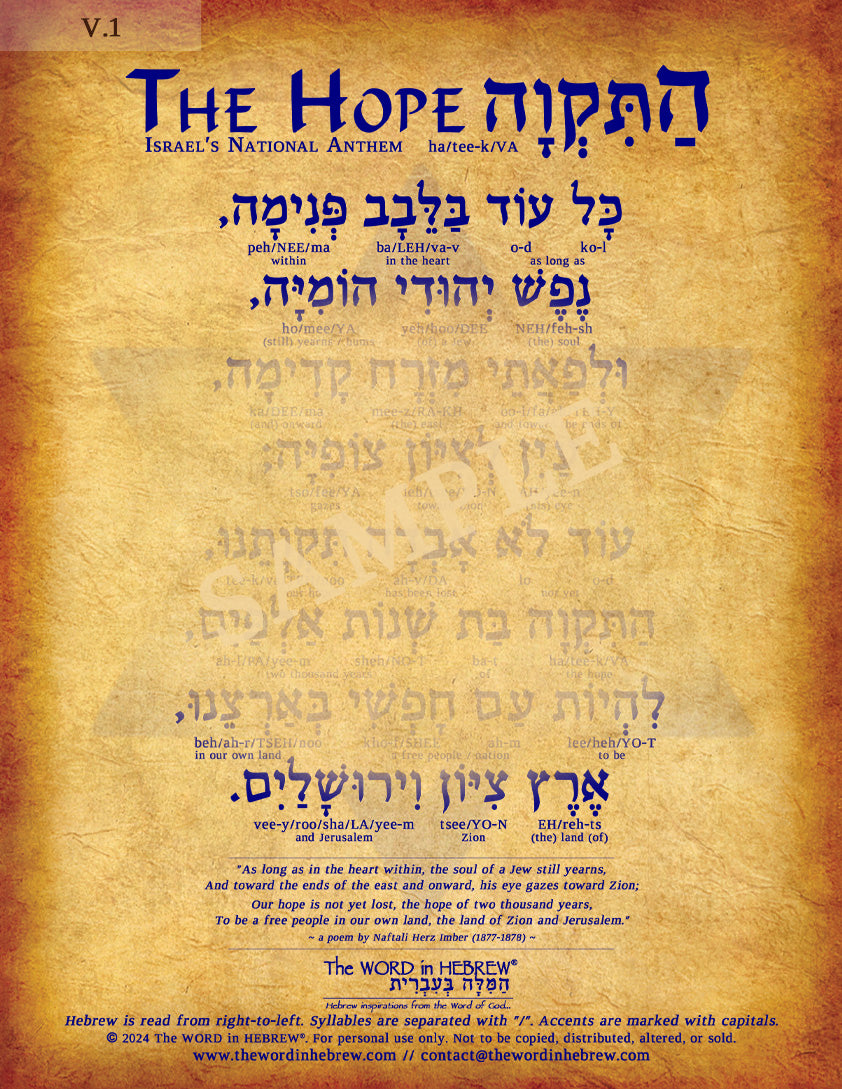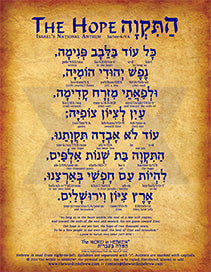Hatikva in Hebrew - Israel's National Anthem in Hebrew
Hatikva in Hebrew - Israel's National Anthem in Hebrew
5.0 / 5.0
(2) 2 total reviews
Learn the National Anthem of Israel - Hatikva in Hebrew! This print features the Hebrew text of "Hatikvah" with each Hebrew word broken into syllables and transliterated using the English alphabet. With minimal effort you will learn to pronounce each word in Hebrew and understand what it means within the context.
Select your format and see more info below!
*Blurred images are for display/copyright only!
SKU:HATIKVA-V1
Couldn't load pickup availability
Video Tutorial: Learn the "Hatikvah" in Hebrew
Additional Product Info
Additional Product Info
This emotional poem was originally written in 1877-1878 by the Jewish poet Naftali Herz Imber from what is now Ukraine. The lyrics of Hatikva reflects the 2,000-year-old desire of the Jewish people to return to the Land of Israel in order to reclaim it as a free and sovereign nation-state. When the State of Israel was established in 1948, "Hatikva" became the national anthem but only unofficially. It did not become the official national anthem until 2004, when the Knesset passed a law making it the national anthem of Israel. In its modern rendering, the official text of the anthem incorporates only the first stanza. The predominant theme in the remaining stanzas is the establishment of a sovereign and free nation in the Land of Israel, a hope largely seen as fulfilled with the founding of the State of Israel. (The melody for "Hatikva" is based from "La Mantovana", a 16th-century Italian song, composed by Giuseppe Cenci in ca. 1600 with the text "Fuggi, fuggi, fuggi da questo cielo".)
“As long as in the heart within, the soul of a Jew still yearns, And toward the ends of the east and onward, his eye gazes toward Zion; Our hope is not yet lost, the hope of two thousand years, To be a free people in our own land, the land of Zion and Jerusalem.”
~ a poem by Naftali Herz Imber (1877-1878) ~
How to use?
How to use?
Hebrew is read from RIGHT-to-left, so you will start from the right and work your way towards the left.
Under each Hebrew word, you will find its transliteration & translation in English. The forward-slash (“/”) separates between syllables and the capitals mark where the accent should be. Pronounce each syllable on its own (left-to-right), then combine the syllables to pronounce the word as a whole.
Make sure you are pronouncing correctly, with my Hebrew Pronunciation Chart.
Specs
Specs
V.1 Print:
- 8″x10″
- Full color
- Printed on 110lb matte cover card-stock paper or similar
- Ready for framing
ECO Print:
- 8.5″x11″
- Printed on 65lb cover vellum with "parchment look"
- Ready for framing
All physical orders are placed in a clear protective sleeve and ship in a rigid (no-fold) envelope.
PDF Download:
- Instant Download (PDF file)
- View on your device or print at home on your choice of paper (8.5″x11″ recommended)
- No Shipping
- FOR PERSONAL USE ONLY!
- See DOWNLOAD INSTRUCTIONS here.
Share













